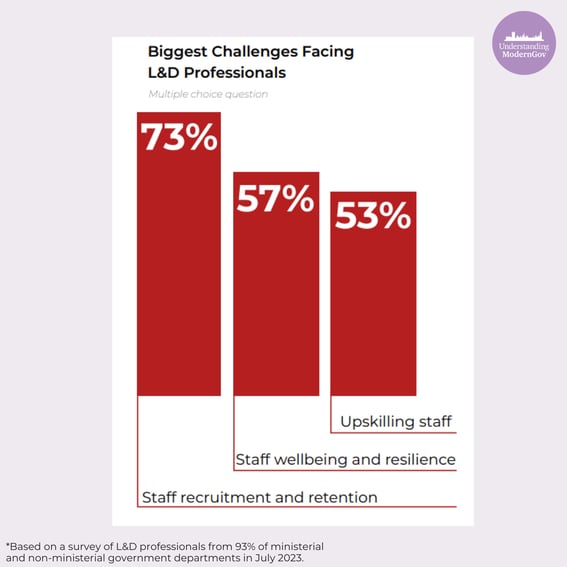Central Government Learning and Development Trends in 2025 & Key Challenges
 Chloe Martin
·
4 minute read
Chloe Martin
·
4 minute read
We conducted a survey in July 2023 to learn about the present and future landscape of learning and development (L&D) in the Civil Service.
We spoke to L&D professionals from 93% of all ministerial and non-ministerial government departments to find out the top L&D challenges and emerging trends that could have a big impact on roles in the future.
In this blog post, we’ll be covering our findings on central government learning and development trends in 2023 and the key challenges facing L&D decision-makers.
Contents:
- Key Challenges Facing Learning and Development Teams in Central Government
- 5 Learning and Development Trends in Central Government in 2023
- Download our White Paper for More L&D Insights
Three Key Challenges Facing Learning and Development Teams in Central Government
Many L&D decision-makers are evaluating their training offerings in 2023 and are on the lookout for solutions for the future. But, aside from securing training, these teams also face other challenges that can directly impact service quality and departmental morale.
When we asked L&D professionals what biggest L&D challenges their department is facing, these were the top three answers mentioned by most:
-
Staff recruitment and retention (73%)
-
Staff wellbeing and resilience (57%)
-
Upskilling staff (53%)
As economic conditions change, skills shortages emerge and organisations transform, the need to recruit, retain and upskill staff has increased. This need to upskill to retain public sector staff is because of the increasing financial competition from the private sector.
According to Statista, the average weekly earnings of public sector staff fell far behind the private sector every month in 2022.
This has intensified the competition for good staff and the difficulty of retaining staff. To combat this, the Civil Service should understand what makes staff stay in roles and how to adapt their approach to recruitment and upskilling the workforce.
The pandemic forced many organisations to act on employee wellbeing due to the cultural shift where staff look for work environments that actively promote wellbeing and psychological safety. A big role in improving staff wellbeing is ensuring all senior leaders are aware of the importance of workplace health and wellbeing. L&D teams can do this through an evidence-based understanding of the causes of absence and any unhealthy practices in the department.
The Civil Service needs managers who can lead the way during uncertain times and teams who are willing to learn and adapt to new situations. Unless the underlying issues are addressed and policies are tailored to the specific department needs, these efforts to improve staff well-being and resilience won’t make a lasting impact.
To ensure the maximum effectiveness of well-being and resilience training, L&D teams should steer clear of treating it as a tick boxing exercise as it risks being meaningless and even ineffective. By offering tailored training that addresses the specific needs of each team, the impact on staff can be more profound and long-lasting.
L&D decision-makers shared the specific challenges facing their organisation:
“The ability to carve out time to carry out training programmes is one of our challenges. We struggle to ensure that legislative / compliance training is completed and so employee development is currently not very prevalent.”
“The de-prioritisation of learning in the current staffing and economic climate and the continuous need to try to demonstrate ROI.”
“Purchasing externally takes months of business cases and decision-making higher up the organisation to get approval – it’s such a struggle and so time-consuming.”
5 Learning and Development Trends in Central Government in 2023
We asked L&D decision-makers what they think are the top emerging trends in the public sector that will have the biggest impact on roles in the next 5-10 years. Here are five key points they addressed:
1. Upskilling and reskilling staff
60% of L&D decision-makers said one of the biggest trends is the upskilling and reskilling of staff in central government. In previous years, public sector processes for hiring and retaining staff have been criticised – especially when it comes to filling talent gaps. By prioritising upskilling and reskilling staff, departments can fill critical skills gaps, boost retention and create a culture of continuous learning and development.
2. Growth in technology
With 58% of L&D decision-makers seeing keeping pace with new technological developments and emerging trends, departments must invest in training that is inclusive to all, valuable for employees and demonstrates direct outcomes. As technology becomes more accessible, training must evolve with it to ensure central government continues to move with inevitable technological changes.
3. Increased pressure on public services
As we gain a greater ageing population, more people needing faster government services and a worsening UK labour supply, the public sector won’t be able to meet these increasing demands through recruitment alone.
56% of L&D decision-makers recognise this as a key trend for 2024. To meet these pressures, L&D teams must analyse their team to discover if there’s untapped potential and how to enhance their skills. Well-trained employees have the skills and knowledge to deliver high-quality services to the public. This enhances the overall efficiency of the service and also ensures public needs are met.
4. Digital transformation
More and more public services look for efficiency and effectiveness through digitisation, which means Civil Service departments may need to work closer together to address these priorities.
As digital transformation is an ongoing process, staff needs to undergo continuous training to stay up-to-date with relevant skills and knowledge. This ensures they are well-equipped to adapt to the changing technological landscape and contribute to their department’s growth and success.
5. Use of AI tools
With increasing access to AI tools, the Civil Service have two key opportunities. The first is to teach the workforce how to use these tools to improve their day-to-day tasks. And the second, using AI to transform public services and certain functions, from complaints or enquiries.
With 48% of L&D decision-makers recognising the importance of AI, the Civil Service can develop more effective processes that benefit people, society and the economy.
Gain More Insights on Central Government Learning and Development with our White Paper
Download your copy of our White Paper to learn more about central government learning and development needs, hurdles and focus areas for 2024.
2+ years in SEO and content marketing. Striving to help public sector professionals develop their skills and learn something new through high-quality content.


%20ld%20trends.jpg?width=800&height=525&name=1%20(2)%20ld%20trends.jpg)

.jpg?width=1279&height=790&name=Screenshot%202023-11-14%20111102%20(1).jpg)




-Dec-07-2023-12-37-05-5954-PM.jpg)